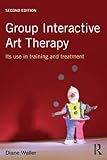Group interactive art therapy : its use in training and treatment / Diane Waller.
Material type: TextPublisher: East Sussex, [England] ; New York, NY Routledge 2015Edition: Second editionDescription: 216 pages : illustrations (black and white, and colour)ISBN:
TextPublisher: East Sussex, [England] ; New York, NY Routledge 2015Edition: Second editionDescription: 216 pages : illustrations (black and white, and colour)ISBN: - 9780415815765 (pbk.) :
- 9780415815765 (pbk)
- 9780415815758 (hbk)
- 616.89152 WAL
- RC489.A7
| Item type | Current library | Call number | Status | Date due | Barcode | |
|---|---|---|---|---|---|---|
| Long Loan | TUS: Midlands, Main Library Athlone Nursing Collection | 616.89152 WAL (Browse shelf(Opens below)) | Available | 220030 | ||
| Long Loan | TUS: Midlands, Main Library Athlone Nursing Collection | 616.89152 WAL (Browse shelf(Opens below)) | Available | 220031 |
Previous edition: 1993.
Includes bibliographical references and index.
Groups and art therapy -- Interactive group psychotherapy -- Curative factors in groups -- Conducting an interactive art therapy group -- Practical matters : materials and rooms -- Using themes or projects within an interactive model -- Short-term interactive art therapy groups -- Group interactive art therapy with children and adolescents -- Rooms and materials -- The unwilling participant(s) : transference, countertransference, projective identification and all ... -- Developmental processes in a group painting -- Life processes in small group environments -- Images of the group -- Catharsis -- Power and domination : clay workshops and sub-group themes -- Splitting in the group: forces of good and evil -- Expressing anger symbolically -- Example of a theme arising spontaneously -- Boundary violation and scapegoating in a training group -- Working through a crisis -- Ending the group : what to do with the images and objects -- The theatre of the image and group interaction / Francesca La Nave -- The visible city and the invisible shame / Jenia Georgieva and Roumen Georgiev -- People with dementia -- People with schizophrenia -- People in rehabilitation from stroke -- Concluding thoughts.
The first edition of this book presented the first theoretical formation of a model integrating the change-enhancing factors of both interactive group psychotherapy and art therapy, demonstrating its use in practice through a series of illustrated case examples. This second edition updates the content of the original in light of the major social, cultural, and political changes of the past two decades and presents new examples of the model in practice. The new edition includes a brand-new section on the use of group interactive art therapy in research with people with dementia, with schizophrenia, and those in rehabilitation from a stroke.
CIT Module PLAC 9003 - Core reading
CIT Module PLAC 9002 - Core reading
CIT Module PLAC 9001 - Core reading
